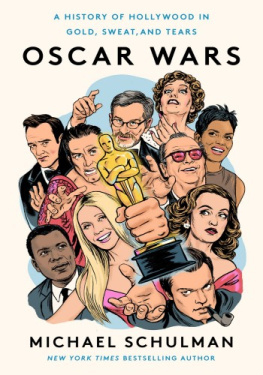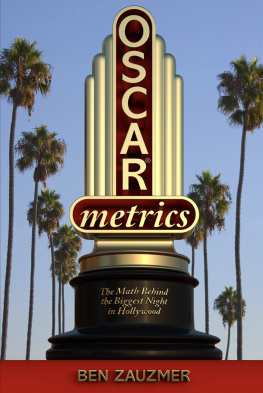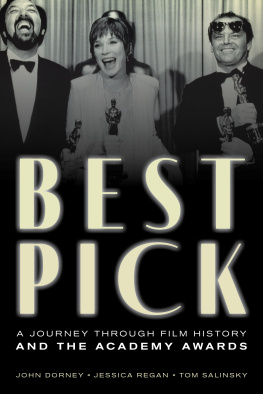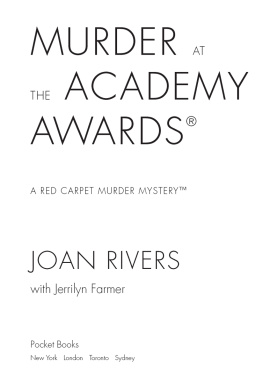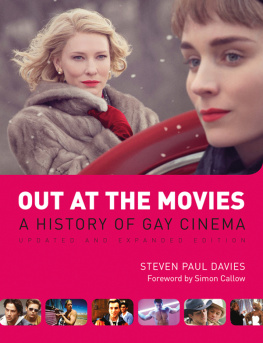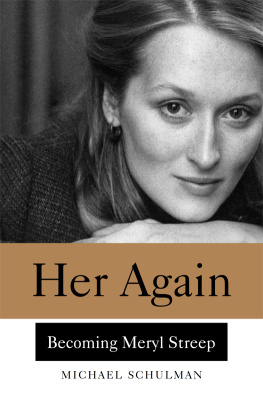Contents
Guide
For my parents,
Nancy and Richard Schulman
Lets get on with this farcical charade of vulgar egotism and pomposity.
Bob Hope
Contents
The Academys turbulent birth
Frank Capra and the attack of the guilds
The plot against Citizen Kane
All about an extraordinary Best Actress race
Three screenwriters and the Hollywood blacklist
The counterculture takes the Oscars
The Oscars fly over the cuckoos nest
Allan Carr and the Worst Oscars Ever
Shakespeare in Love vs. Saving Private Ryan
Hattie McDaniel, Sidney Poitier, and Halle Berry make history
#OscarsSoWhite and a chaotic night
T he Oscars, it should be said at the start, are always getting it wrong. Twenty-four centuries after Euripides came in third place at the Athenian dramatic festival, Brokeback Mountain lost Best Picture to Crash, and the outcry will probably last another twenty-four centuries.
The ostensible purpose of the Academy Awards is to honor excellence in movies. But that lofty goal is what Alfred Hitchcock would have called a MacGuffinthe plot device that gets the real drama going. Each Oscar year is a suspense tale, a choose-your-own-adventure story. Like any good Hollywood screenplay, it has burgeoning conflict, a colorful cast of characters, and a few plot twistsall climaxing on a glittering stage, under the glare of the cameras and millions of viewers. Subplots ricochet down the ages with new players: the neglected masterpiece, the overreaching campaign, the breathless starlet. Elizabeth Taylor becomes Julia Roberts; Citizen Kane cross-fades into Do the Right Thing.
What are the Academy Awards, anyway? The answers vary. Theyre a vaunted tradition celebrating a great modern art form. Theyre an industry partylike a convention of landscapers, but with better outfits. Theyre the closest thing America has to royalty. Theyre the only thing forcing Hollywood to factor art into commerce. Theyre a marketing ploy propping up a multibillion-dollar business. Theyre a method, however dubious, of organizing movies into a canon. Theyre a game. Theyre a relic. Theyre a fashion show. Theyre a horse race. Theyre an orgy of self-congratulation by rich and famous people who think too highly of themselves. Theyre the Gay Super Bowl.
This book argues, in eleven installments, that theyre something else, too. The Oscars are a battlefield where cultural forces collide and where the victors arent always as clear as the names drawn from the envelopes. The red carpet runs through contested turf, but it can take years to see what the real battle lines were. An aesthetic sea change that sets the tone for a decade might be buried in the screenplay nominations. A political upheaval might be a whisper one year, a roar the next. Like Hollywoods greatest sagasStar Wars, The Godfatherthe Oscars often play out as a drama of generational conflict, as a new cohort shows up to displace the old. A young upstart may recur decades later as an industry heavyweight: the boyish Steven Spielberg who gets snubbed for Jaws becomes the establishment bigwig of Saving Private Ryan.
In recent years, the Oscars have become a conflict zone for issues of race, gender, and representation, high-profile signifiers of whose stories get told and whose dont. These reckonings are a long time coming. The #OscarsSoWhite campaign reached a crescendo in 2016, the same year America went through a political paroxysm steeped in racial animus. But #OscarsSoWhite grew out of a centurys worth of absence, punctuated by lonely victories for such Black stars as Hattie McDaniel, Sidney Poitier, and Halle Berry. The next year, the Harvey Weinstein scandal took out one of the Oscars most contentious players and tarnished Hollywoods self-enshrined mythos, but it echoed back to Harry Cohns Oscar-encircled casting couch at Columbia Pictures.
In previous decades, Oscar wars were waged over different issues, but they were no less fraught. In the thirties, Hollywoods insurgent labor movement turned the Academy into Public Enemy No. 1, as workers boycotted the ceremony and nearly killed off the Oscars in their adolescence. In the fifties, the Academy bent to the paranoia of the House Un-American Activities Committee, forcing blacklisted screenwriters to hide behind false nameseven as they won Oscars. In the late sixties, with the studio system crumbling and the generation gap wide open, the Oscars were besieged by young people with long hair and risqu tastes, as movies like Easy Rider heralded the arrival of the New Hollywood. In the nineties, an indie uprising brought in a rambunctious new crowd, led by a man who turned Oscar campaigning into a blood sportwhen he wasnt doing far worse in the shadows.
If theres a common thread running through the decades of Oscar wars, its power: who has it, whos straining to keep it, whos invading the golden citadel to snatch it. The Oscars are perpetually redrawing the bounds of the Hollywood establishment, pitting eminences against arrivistes, conventionalists against iconoclasts. As soon as the Academy Award was invented, people in Hollywood wanted it, because it created an organizing principle for power and prestige in a town whose hierarchy is always shifting beneath its denizens feet. The statuette is a talisman that elicits powerful desiresfor attention, for recognition, for cloutdriving its suitors toward folly or excess or desperation. Art isnt meant to be ranked like a sports team or scored like a tennis match, but human nature drives us toward gamesmanship: we like watching people win or lose, and if given the chance, we want to win.
I STARTED WATCHING THE A CADEMY Awards in the early nineties, when Billy Crystal was the regular host and began each ceremony with a zingy comic medley. And not an ounce of smut, / It aint called Howards Butt! / They call it Howards End, he crooned in 1993, to the tune of Hooray for Hollywood. I hadnt seen any of the Best Picture nominees, but to my adolescent brain, it was the height of comedy, the Olympus of schmaltz. As an adult, I organized office Oscar pools and memorized acceptance speeches. In 2016, as a writer at The New Yorker, I covered the Academys tumultuous year in the wake of #OscarsSoWhite. Led by its first Black president, Cheryl Boone Isaacs, and its CEO, Dawn Hudson, the Academy was under fire for an initiative to recruit new, diverse members and demote others who had been inactive in the industry to emeritus statusa plan that had old-timers looking at their IMDb pages and panicking. The issue had cracked open Hollywoods fault lines of age and ideology, but, as I soon learned, it had all happened before. In 1970, the same year Midnight Cowboy became the first X-rated movie to win Best Picture, Academy president Gregory Peck had launched a similar plan to yank the membership into the presentand had also received rafts of angry letters. Now some of the hip, young talents of the New Hollywood were seasoned pros writing incensed op-eds in The Hollywood Reporter, howling against their perceived obsolescence.
In February 2017, I went to the Oscars for the first time. Sitting in the pressroom at the Loews Hollywood Hotel, where dozens of journalists from around the world sat at long tables, I watched the show on a monitor. Occasionally, the newly minted winners were shown in to answer questions. In the back of the room was a reference table where Academy librarians sat with thick binders. Toward the end of the night, the energy in the room flagged, as we lurched toward an inevitable Best Picture win for


